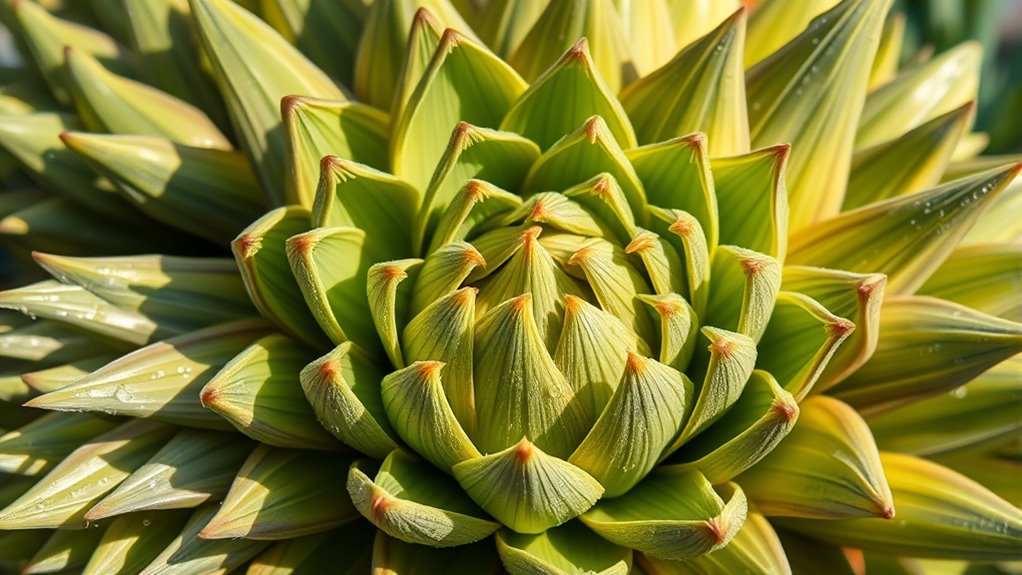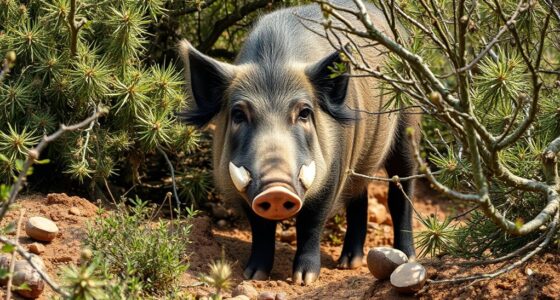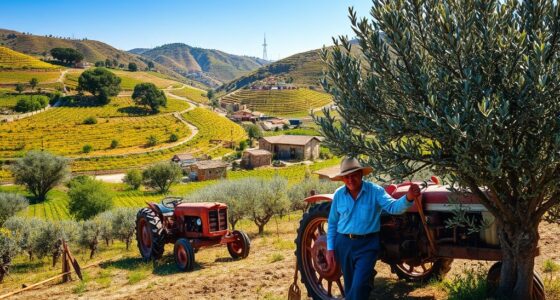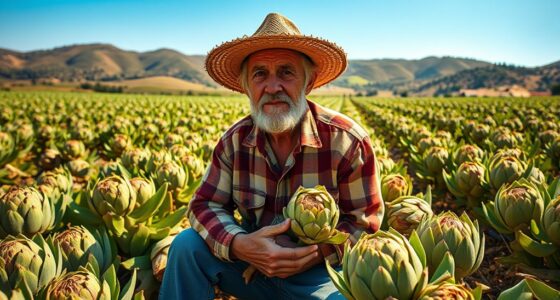Sardinian spiky artichokes are striking vegetables with large, spiny green and purple-tinged leaves that grow in warm, well-drained soils. They have a bold flavor combining mild bitterness with natural sweetness, enhanced by their herbaceous aroma. Cultivated mainly in coastal microclimates, they follow strict PDO standards, with harvests from late October to spring. Their unique taste comes from Sardinia’s rich soil and climate, and understanding their special qualities will make you appreciate them even more.
Key Takeaways
- Sardinian spiky artichokes are tall, spiny plants with large, dark green or purple-shaded leaves, cultivated mainly for their tender, flavorful hearts.
- They thrive in well-drained, fertile soils with mild coastal climates, ensuring optimal growth and high-quality harvests.
- Their distinctive flavor balances mild bitterness with natural sweetness, complemented by a vibrant, herbal aroma.
- Harvesting occurs mainly from late October to December, with careful selection of firm, bright green heads for freshness.
- Certified PDO, these artichokes hold cultural significance and are integral to traditional Sardinian cuisine.
Botanical Features and Physical Appearance
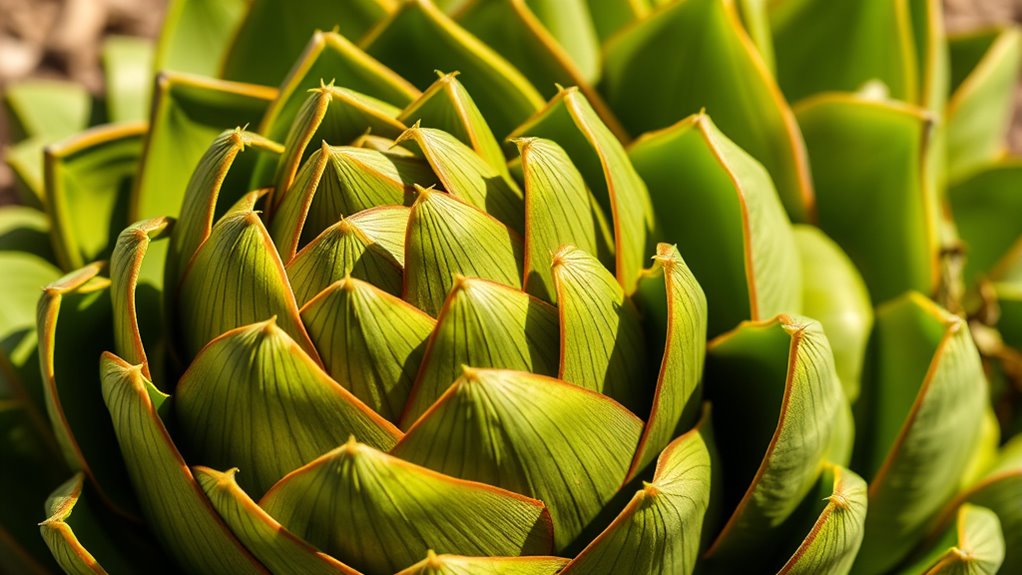
The Sardinian spiky artichoke is a striking plant characterized by its tall, compact stature and distinctive spiny features. Typically, it grows between 70 and 140 centimeters tall, with large, thick, dark green leaves that sometimes display purple shading. The plant forms a rosette of leaves surrounding a long, sturdy flower stem, which can reach up to 70 centimeters. Its conical, elongated head ends in a pointed yellow spine or thorn, protected by thick, spiny bracts with purple or bluish hues. The head’s size varies from medium to medium-large, usually 7-9 centimeters in diameter. The base of the bracts is fleshy and tender, providing a crunchy texture. Overall, the plant’s robust, spiny appearance makes it easily recognizable. Proper installation and maintenance are essential to ensure safety and health of the plant.
Flavor Profile and Organoleptic Characteristics
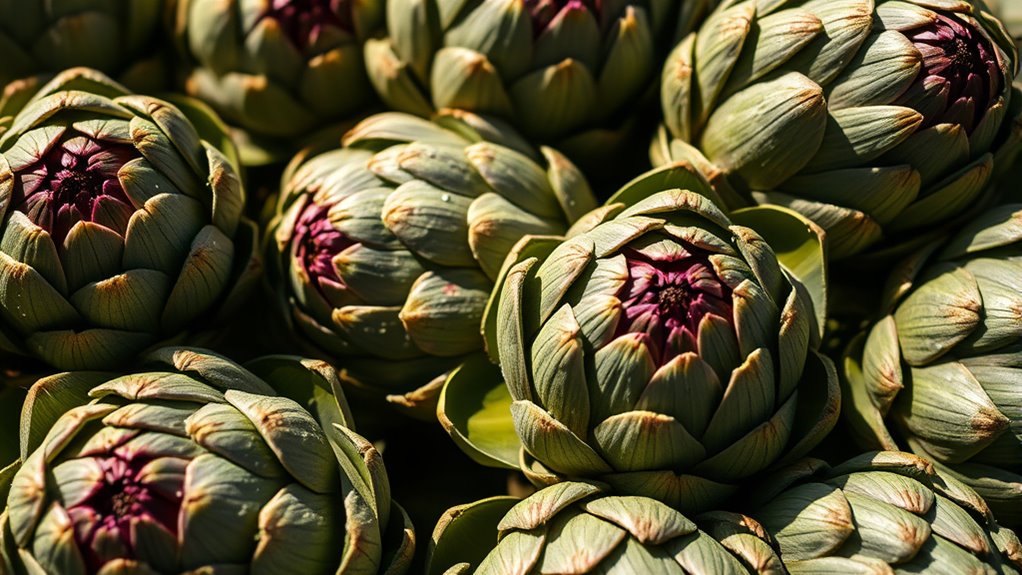
You’ll notice that Sardinian spiky artichokes have a distinctive flavor, balancing mild bitterness with natural sweetness for a complex taste. Their aroma is vibrant and herbaceous, enhancing the overall sensory experience, while their tender yet crunchy texture provides a satisfying bite. These qualities make them versatile in dishes, especially when paired with local cheeses and wines. They are preserved naturally in organic sunflower or Italian olive oil, which helps maintain their flavor integrity and enhances their aromatic qualities. Additionally, sustainable preservation methods support eco-friendly practices and help preserve local culinary traditions.
Flavor Balance and Notes
Sardinian spiny artichokes offer a distinctive flavor profile marked by a delicate balance of bitter and sweet notes. You’ll notice the subtle sweetness complements the natural vegetal bitterness found in the leaves and heart, creating a harmonious taste. The bitterness is pleasant and mellow, never overpowering, which enhances their culinary versatility. Their full-bodied, intense flavor features rich, aromatic qualities with a slightly nutty, tangy, and grassy undertone. Sometimes, citrus and floral hints emerge, especially with preservation methods like lemon and sea salt. Spicy or peppery nuances may also appear depending on preparation. This balanced flavor, influenced by Sardinia’s unique soil and climate, provides a refined yet bold taste experience, making these artichokes a true reflection of their terroir. The D.O.P. certification guarantees the authenticity and quality of the product, ensuring that consumers enjoy genuine Sardinian flavor at its best.
Aroma and Textural Qualities
Aromatic and textural qualities define the distinctive sensory appeal of Sardinian spiny artichokes. You’ll notice an intense, recognizable scent with fresh vegetal and herbal nuances that reflect the island’s terroir. The aroma balances aromatic bitterness with subtle sweetness, adding complexity and making it engaging even before tasting. The texture is unique: tender yet satisfying, with a crunchy outer layer contrasting a soft, fleshy core. The sharp, thorny bracts contrast with the smooth inner parts, creating a duality that enhances the eating experience. Flavors combine pronounced bitterness with sweet, nutty, and buttery hints, often intensified by simple seasonings like lemon and sea salt. The sensory interplay of aroma, texture, and flavor creates a memorable, regional palate that’s both bold and refined. Cultivation between June and August and the specific micro-climates of Sardinia contribute to these distinctive qualities, making each artichoke a true expression of its terroir. Additionally, the harvesting process ensures that only the freshest, most flavorful buds reach consumers, further elevating their unique sensory profile.
Cultivation Regions and Growing Conditions
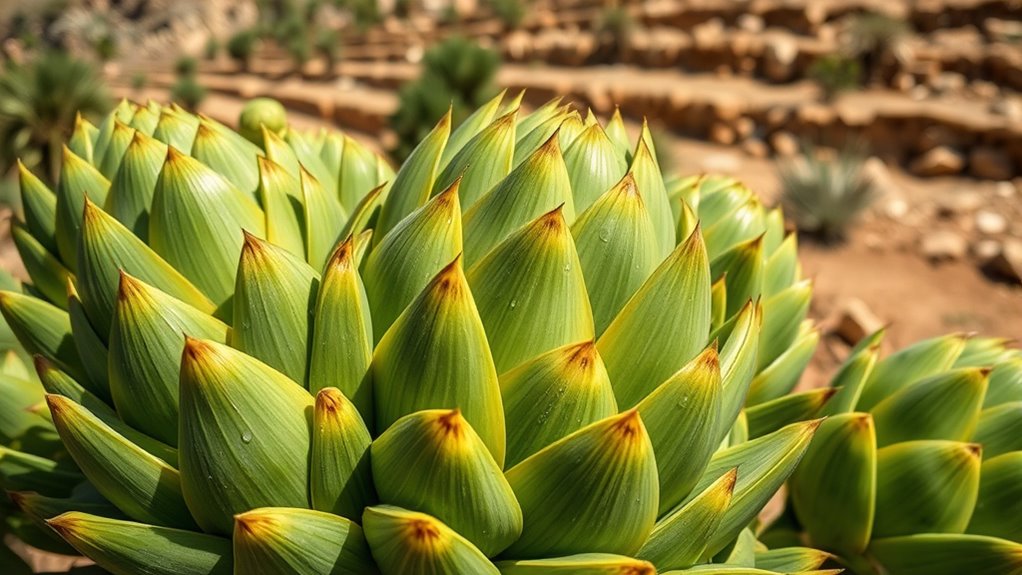
You’ll find Sardinian spiky artichokes thrive in coastal and valley soils with good drainage and moderate dryness. The region’s mild winters and coastal microclimates create ideal conditions for consistent growth and harvests. Understanding these soil and climate preferences helps explain why they’re specially suited to Sardinia’s unique terrain. Their ability to tolerate mild winter temperatures further contributes to their successful cultivation in this environment. Additionally, the resilience of these plants is enhanced by their adaptation to the region’s specific climate conditions, making them well-suited for sustainable farming practices.
Sardinian Climate Suitability
The success of cultivating spiky artichokes in Sardinia hinges on the island’s unique microclimates, which provide ideal conditions for growth. You’ll find cultivation mainly in coastal and valley areas with stable, mild winters that minimize frost risk. Regions like Campidano, Sulcis, and Oristano offer the perfect balance of humidity, temperature, and proximity to water sources, supporting healthy development. Coastal plains, such as Campidano, are especially suited for the Spinoso variety, while southern areas focus on early varieties. Sardinia’s climate allows for transplantation from late June to early August, with harvesting from September to May. Climate change is prompting shifts toward earlier varieties, ensuring the crop adapts to evolving seasonal patterns. Stable, mild conditions are essential for high-quality, flavorful artichokes. Additionally, understanding the growing conditions and microclimates of the region can help optimize cultivation practices for better yields.
Soil and Terrain Preferences
Sardinian spiky artichokes thrive best in fertile, well-draining soils that are rich in organic matter. You should amend the soil with well-aged compost to improve structure and moisture retention. Avoid heavy clay or waterlogged soils, as these cause root rot and stunt growth. Slightly sandy or loamy soils help enhance drainage while maintaining nutrients. Keep the soil pH neutral to slightly alkaline for essential nutrient uptake, though specific Sardinian pH data is limited. The terrain should be flat or gently hilly, providing good sunlight and natural drainage. Hillsides with good exposure reduce fungal risks, while avoiding frost pockets and cold air drains is vital. Proper soil preparation, weed removal, and mulching support healthy development and protect against extreme temperatures. Choosing the right terrain is essential for optimal growth and yield. Additionally, understanding local climate conditions can help prevent issues related to frost and temperature fluctuations that may affect crop health.
PDO Certification and Production Standards
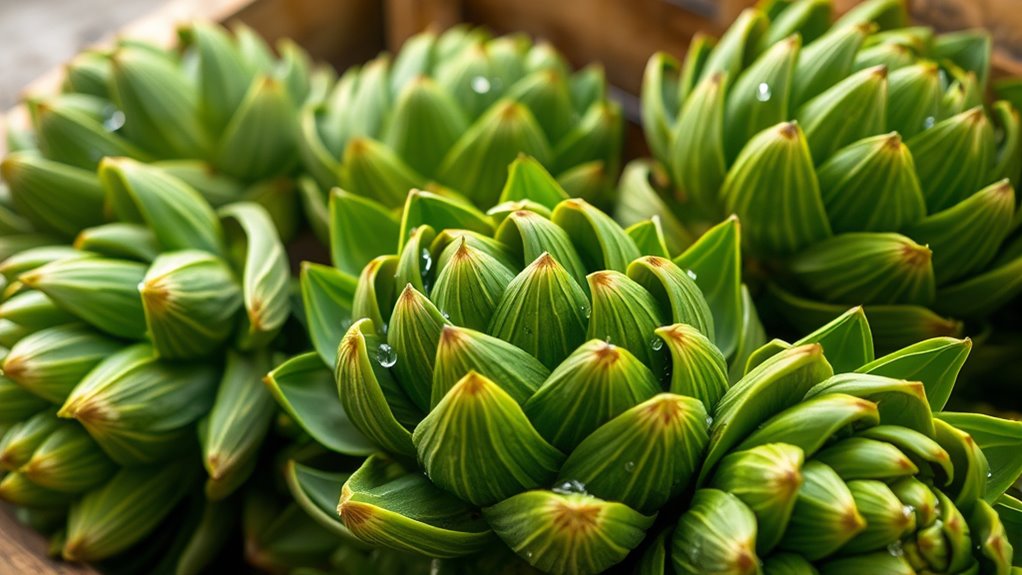
PDO certification for Sardinian Spiny Artichokes guarantees that every stage of production—from cultivation to processing—takes place within designated local areas, preserving traditional methods and regional characteristics. This certification ensures high quality, protects against counterfeiting, and highlights the artichoke’s unique organoleptic qualities. All production must adhere to strict environmental criteria, with cultivation limited to specific coastal and riverbank zones featuring distinctive soil and microclimates. Transplanting occurs between mid-June and early August, while hand-harvesting takes place from September to May, following traditional practices. The artichoke must meet quality standards, including minimum carbohydrate content, guaranteeing consistency. The certification process also involves rigorous quality control procedures. PDO standards also regulate post-harvest handling, maintaining freshness and authenticity, and allowing Sardinian producers to access European and global markets with confidence. Additionally, adherence to environmental sustainability practices is a key requirement, ensuring the preservation of local ecosystems and biodiversity.
Agricultural Cycle and Harvesting Practices
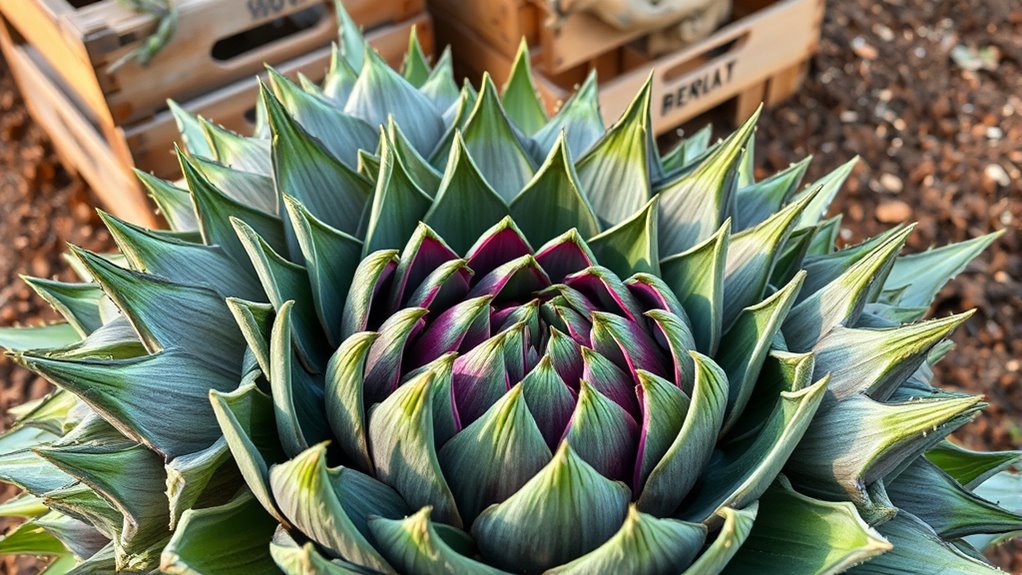
Planting of artichokes in Sardinia typically takes place in mid-August to guarantee the plants establish well before winter. You’ll plant them in small spherical holes about 25 cm deep and 50 cm apart, giving roots enough space to develop. Choose sites with mild climates on flat or hilly terrain, avoiding frost below zero Celsius to prevent damage. Use drip irrigation systems to keep soil consistently moist, especially during dry spells. The soil should be well-drained and rich to support vigorous growth. Transplant seedlings or pups, which should be at least six inches tall with healthy roots and 2-3 true leaves, in early spring or fall. Maintain about four feet between plants, and mulch to retain moisture and keep roots cool. Proper planting techniques are essential for healthy growth and productive harvests. Additionally, implementing irrigation management practices can optimize water use and improve crop yields. This cycle ensures healthy growth and productive harvests.
Nutritional Composition and Health Benefits
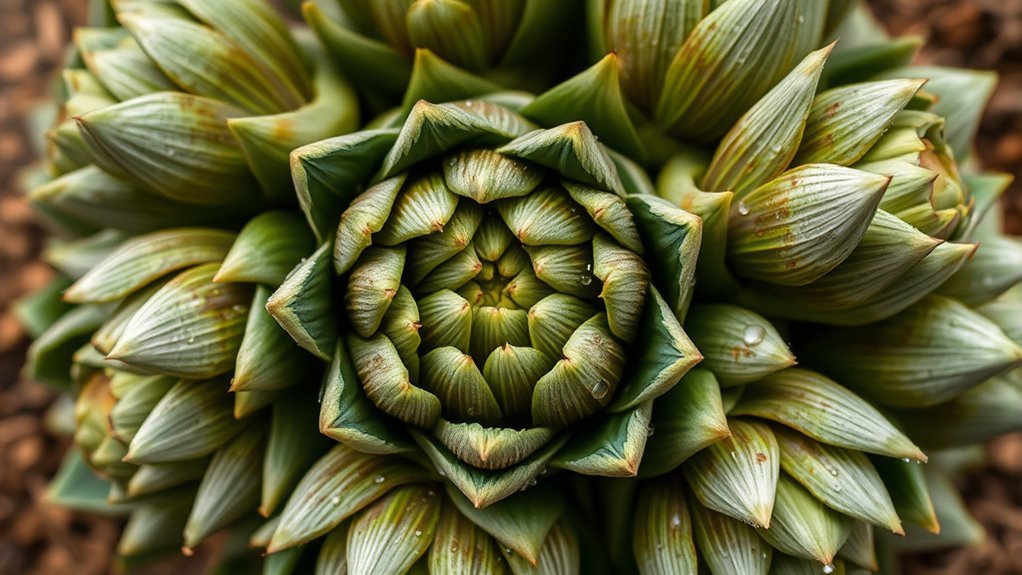
You’ll find Sardinian spiky artichokes packed with antioxidants like polyphenols, which fight free radicals and support your immune health. Their high fiber content promotes digestion, keeps your gut healthy, and helps control blood sugar levels. Incorporating these artichokes into your diet can boost overall wellness and protect your cells from oxidative stress. Additionally, their rich supply of vitamins and minerals contributes to maintaining healthy skin and supporting heart health. These nutrient-rich vegetables can also aid in detoxification and improve liver function, further enhancing their health benefits.
Rich in Antioxidants
Rich in antioxidants, Sardinian spiky artichokes pack a powerful nutritional punch that benefits your health. They are loaded with phenolic compounds like polyphenols, cynarin, and caffeic acid, which act as natural defenders against free radicals. These antioxidants remain stable even after cooking, ensuring you get their full benefits. The high polyphenol levels give these artichokes a superior antioxidant profile compared to other varieties. Additionally, they contain vitamins A, C, niacin, and riboflavin, which help protect your cells, support your immune system, and promote tissue repair. Their mineral content, including potassium, magnesium, iron, and manganese, further boosts antioxidant enzyme activity and cellular health. Research indicates that these antioxidants can also aid in reducing inflammation and improving cardiovascular health. Altogether, these compounds support detoxification, reduce oxidative stress, and contribute to overall well-being.
Supports Digestive Health
The high fiber content in Sardinian spiky artichokes plays a crucial role in supporting digestive health. This fiber, split evenly between soluble and insoluble types, keeps your gut moving smoothly and encourages the growth of healthy bacteria. With inulin in the heart of the artichoke, you benefit from lowered cholesterol, better nutrient absorption, and easier digestion. The extra fiber adds bulk to your stools (preventing constipation), while soluble fiber helps control blood sugar levels by slowing carbohydrate absorption. Additionally, cynarin stimulates bile production, aiding fat digestion and detoxifying your liver. The rich mineral content, including potassium, calcium, and magnesium, supports muscle function and gut motility. Vitamins A, C, B2, and K further strengthen your gut lining and immune defenses, making Sardinian artichokes a true digestive ally. The low calorie density of Sardinian spiky artichokes ensures they can be enjoyed regularly without contributing to weight gain.
Unique Soil and Climate Influences on Quality
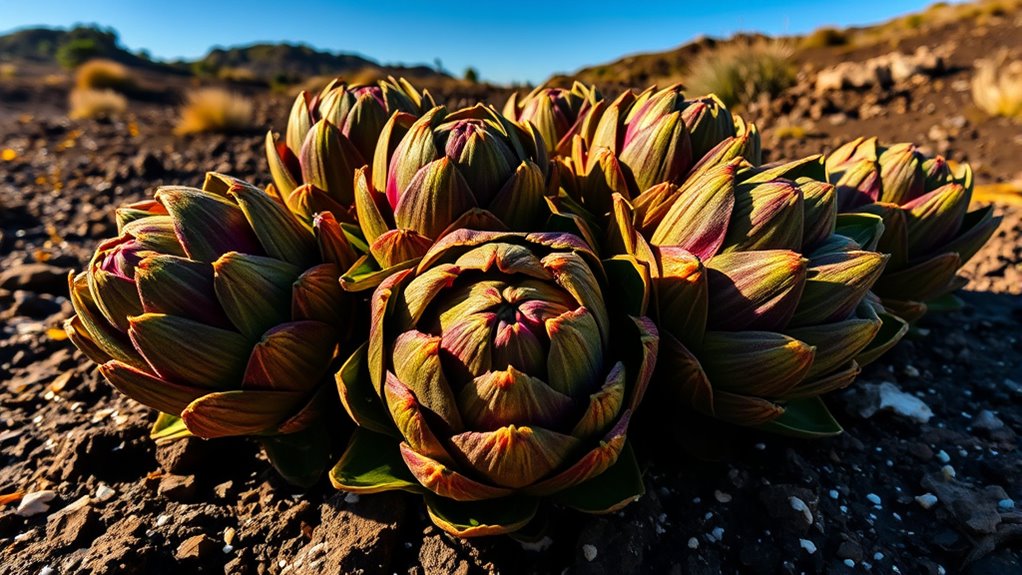
Sardinian spiky artichokes develop their distinctive quality thanks to the island’s unique combination of soil and climate conditions. You’ll find they thrive in fertile, well-drained loamy soils enriched with organic matter like compost or manure, which supports vigorous growth. Slightly acidic soils optimize nutrient uptake, ensuring healthy plants. Sardinia’s mild Mediterranean climate provides moderate temperatures between 15°C and 27°C, ideal for avoiding bitterness. Ample sunshine boosts development, while afternoon shade helps during intense heat. The region’s terrain—flat or gently hilly—offers excellent drainage and microclimates that influence size and flavor. Consistent water from drip irrigation and mulching preserves soil moisture and prevents stress. These soil and climate factors work together, producing artichokes with enhanced tenderness, flavor, and the iconic spiky appearance Sardinia is known for. The region’s unique environmental conditions also contribute to the artichokes’ resilience against pests and diseases, further enhancing their quality.
Planting and Maintenance Techniques
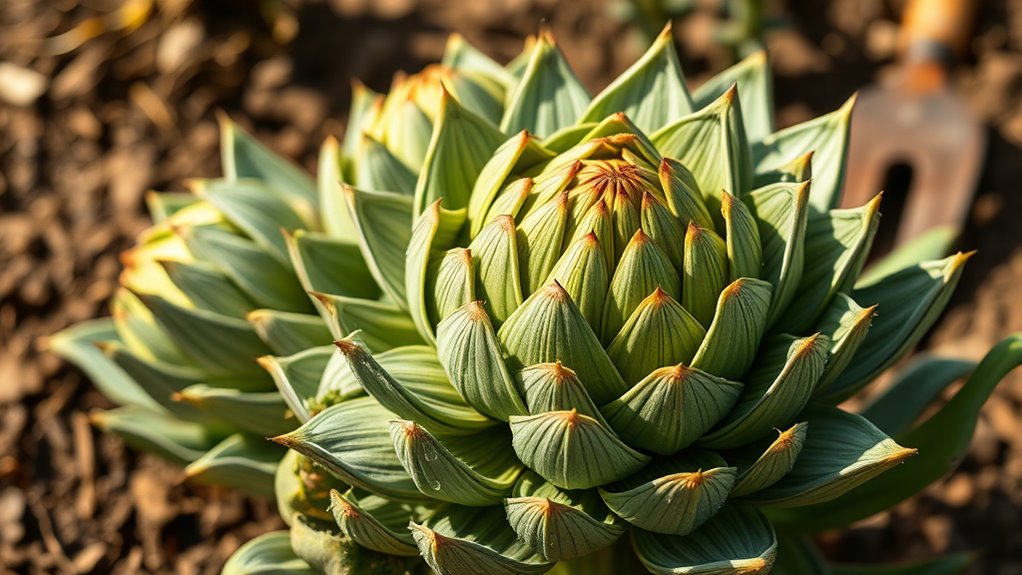
To guarantee healthy growth and a good harvest, you’ll need to follow effective planting and maintenance techniques. First, sow your artichoke seeds 1/4 to 1/2 inch deep in lightweight, well-drained mix, and pre-soak them for 24 hours to boost germination. Keep soil temperature around 70-80°F, using bottom heat if possible, and cover with a humidity dome to keep moisture steady. Once seedlings emerge, thin out weaker ones to foster strong, vigorous plants. Starting plants early with vernalization (2 weeks at 40°-50°F) triggers flowering, which can help improve their productivity. Here are key steps to follow: 1. Start seeds indoors 8-10 weeks before the last frost, providing ample light and warmth. 2. Transplant after four true leaves, gradually hardening them off. 3. Water deeply and consistently, mulching to retain moisture and prevent waterlogging. Stay attentive, and your plants will thrive.
Harvest Timing and Quality Indicators
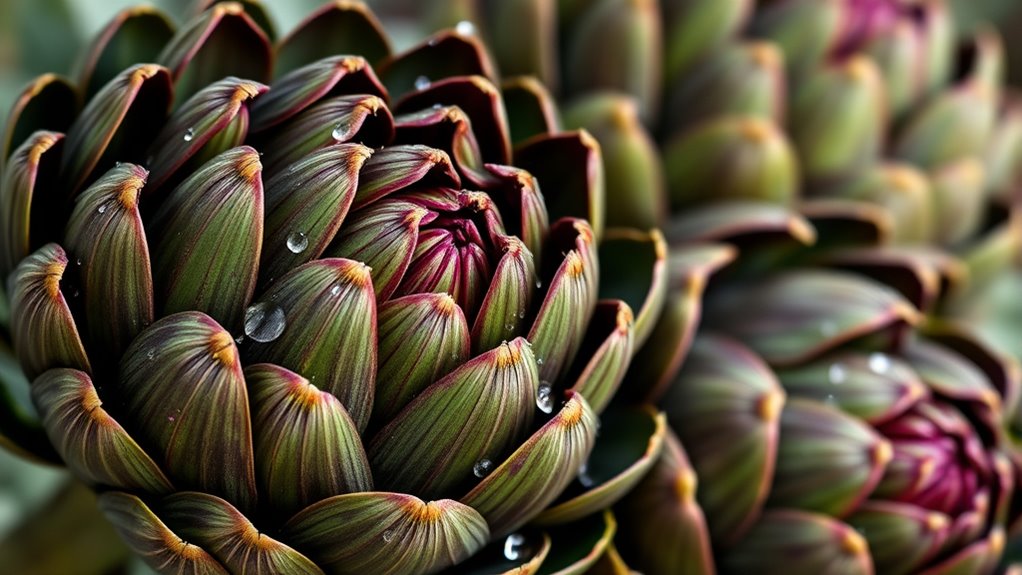
Timing your harvest correctly is essential to capturing the artichoke’s peak flavor and tenderness. You should pick them before the flower buds open, ensuring they stay tender and avoid becoming tough. Harvest typically starts at the end of October through November and December, with a second peak from March to April. The main productive cycle runs from mid-October to January or February, though markets often supply artichokes year-round thanks to staggered plantings. Look for medium to large heads—about 7–9 cm—featuring bright green, compact bracts with purple shading, and a firm, crisp texture. The aroma should be floral and thistle-like, indicating freshness. A full-bodied, balanced taste with mild bitterness and natural sweetness signals high quality—key indicators to maximize flavor and marketability. Proper harvesting timing depends on the specific growth stage and environmental conditions, which directly influence the organoleptic qualities of the Sardinian Spiny Artichoke.
Culinary Uses and Traditional Recipes
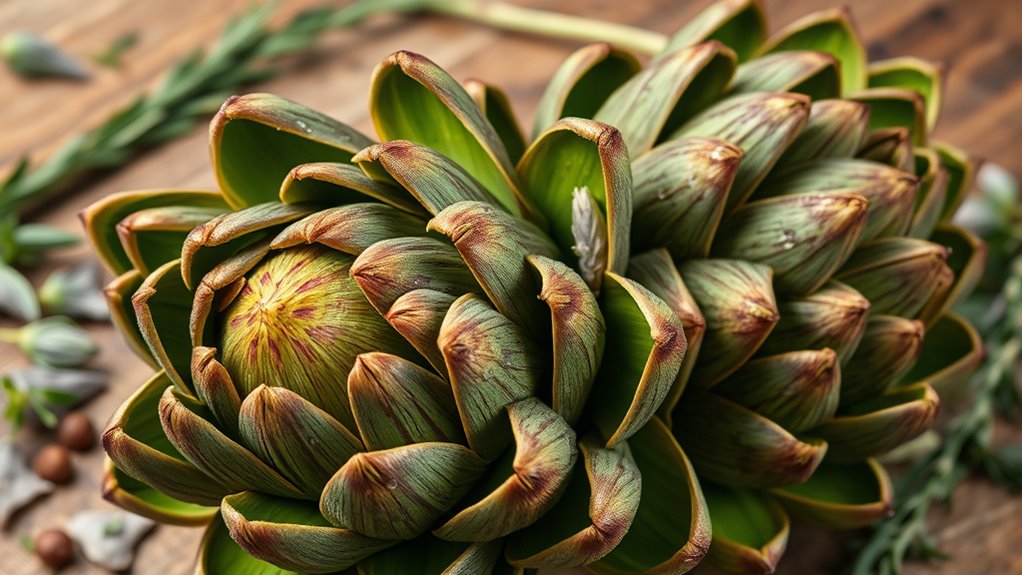
Spiky artichokes from Sardinia lend themselves to a variety of culinary preparations, showcasing their tender texture and unique flavor. You can enjoy them raw in salads, thinly sliced and dressed simply with lemon juice and olive oil to highlight their delicate vegetal notes. To evoke emotion, consider these traditional uses:
- Savor them with lamb at Easter, where simmered artichokes meld with tender meat and aromatic herbs.
- Braise and stuff them with garlic, mint, and parsley, creating moist, herb-infused bites perfect for sharing.
- Incorporate them into rustic Panada pies or Sardinian pasta dishes, balancing earthiness with cheesy richness.
These methods highlight their versatility, allowing you to experience Sardinian culinary artistry while savoring the artichoke’s fresh, nuanced flavor. The dish emphasizes the taste of artichokes combined with lamb, making it a festive and meaningful culinary tradition.
Frequently Asked Questions
How Does the Spiny Texture Affect Preparation and Cooking Methods?
The spiny texture markedly influences how you prepare and cook artichokes. You’ll need sharp tools and gloves to handle them safely and remove tough outer leaves. Trimming the spines and peeling stems can take extra time, but it’s essential for tender results. Cooking methods like boiling, steaming, or braising help soften the fibrous parts and preserve flavor, ensuring you enjoy their unique texture and flavor profile without injury or waste.
What Distinguishes Sardinian Spiky Artichokes From Other Varieties Globally?
You’re in for a treat when you explore Sardinian spiky artichokes—they stand out like a sore thumb worldwide. Their full-bodied flavor, blending bitterness with sweetness, sets them apart, thanks to unique polyphenols and cynarin. The tender yet crunchy texture, vibrant colors, and intense floral aroma make them a culinary jewel. These PDO-certified delights not only honor tradition but elevate any dish, making them truly one-of-a-kind in the global market.
Are There Specific Pests or Diseases That Threaten These Artichokes?
You should be aware that Sardinian spiky artichokes face specific threats from pests and diseases. Insects like aphids, armyworms, and snails damage your plants by feeding or tunneling into stems and leaves. Diseases such as botrytis rot, powdery mildew, and root rot can also affect crop health, especially in wet or poorly drained conditions. Regular monitoring, good sanitation, and organic controls help protect your artichokes from these threats.
How Does the PDO Certification Impact Export Opportunities?
Did you know PDO certification can boost exports by up to 20%? It directly impacts your ability to access international markets by certifying the Sardinian spiky artichoke’s authenticity and quality. This label helps you meet EU standards, builds consumer trust, and commands higher prices. With PDO, your product stands out as a premium, authentic choice, opening doors to global gourmet markets and strengthening your export opportunities.
Can the Flavor Profile Vary Significantly Between Harvest Seasons?
Yes, the flavor profile can vary quite a bit between harvest seasons. In early harvests, you’ll notice a more tender, crisp texture with floral aromas, while late-season artichokes tend to be slightly fiber-rich with a sharper, more intense flavor. Environmental factors like temperature, rainfall, and plant maturity influence this, so you might find subtle differences in bitterness and sweetness depending on when you enjoy them.
Conclusion
As you explore the world of Sardinian spiky artichokes, you’ll discover they’re more than just a vegetable—they’re a symbol of tradition and nature’s artistry. With their unique soil and climate shaping their flavor, each bite becomes a journey through Sardinia’s rich heritage. So, next time you savor these spiky treasures, remember you’re tasting a legacy carved by the land itself—an edible masterpiece waiting to be enjoyed.
